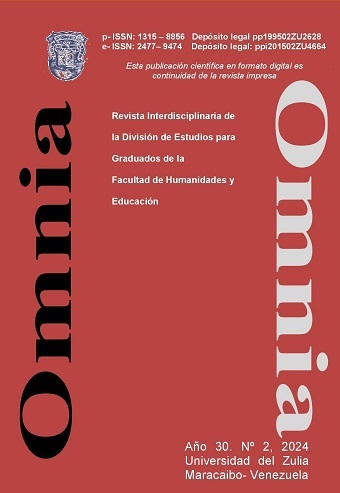Realidad virtual como estrategia de aprendizaje en un Colegio de Maracaibo, Venezuela
Resumen
A medida que el mundo continúa adoptando la transformación digital, el ámbito de la educación no se queda atrás. La realidad virtual (RV) es la creación de un entorno simulado con apariencia totalmente real que permite trasladar a una persona a cualquier lugar o situación que desee, con la ilusión de estar dentro de este ambiente. Esta investigación se centró en demostrar que la realidad virtual funciona como una estrategia de aprendizaje, donde se involucra a los estudiantes a aprender a través de una simulación computarizada con imágenes y vídeos que crea en el usuario la sensación de estar inmerso en el entorno que presenta el vídeo, contemplado a través de un dispositivo conocido como gafas o casco de realidad virtual. La metodología aplicada fue experimental. Se tomó una muestra total de 24 estudiantes los cuales fueron separadas en dos grupos de 12 personas cada uno, mientras un grupo presenciaba una clase tradicional de biología en diapositivas, el otro presenciaba la misma clase usando la RV, al finalizar se les realizó una prueba escrita con el objetivo de demostrar qué grupo tuvo un mejor rendimiento en un rango de 0-20. La clase tradicional obtuvo 13 puntos como resultado, la clase con RV tuvo un promedio de 16,33. Una vez analizados dichos resultados se concluye y se demuestra que la Realidad Virtual puede ser aplicada como método alterno, educativo y efectivo presentando notables cambios en el rendimiento académico
Descargas
Citas
Arraez, David (2016). La realidad virtual en las aulas: ¿Realidad o virtual?. Educación 3.0. Disponible en: https://www.educaciontrespuntocero.com/noticias/realidad-virtual-aulas-educacion/
Castañares, Wenceslao (2011). Realidad virtual, mímesis y simulación. CIC. Cuadernos de Información y Comunicación, 16. 59-81. ISSN: 1135-7991. Recuperado de: https://www.redalyc.org/articulo.oa?id=93-521629004.
Dabbagh, Nada, Fake, Helen y Zhang, Zhicheng (2019). Student Pers-pectives of Technology Use for Learning in Higher Education. RIED. Revista Iberoamericana de Educación a Distancia, 22(1), pp. 127-152. doi: http://dx.doi.org/10.5944/ried.22.1.22102.
Fernández, Ruben, González, David y Remis, Saul (2012). De la reali-dad virtual a la realidad aumentada. Material de lectura, Open DC. Disponible en: http://fido.palermo. edu/servicios_dyc/opendc/archivos/4674 open.pdf.
Ferreira, Regivaldo Sousa, Xavier, Rogerio Aparecido y Ancioto, Alex Sandro (2021). La realidad virtual como herramienta para la edu-cación básica y profesional. Revista Científica General José María Córdova, 19(33), 223-241. http://dx.doi.org/10.21830/19006586.728.
Michaelis, Carolina y Michaelis Henriette (2020). Dicionário brasileiro da língua portuguesa. https://michaelis.uol.com. br/moderno-portugues/
Tori, Romero, Hounsell, Marcelo da Silva y Kirner, Claudio (2018). Realidade virtual. Introdução a Realidade Virtual e Aumentada (pp. 9-25). Editora SBC.
Morán, José (2015). Mudando a educação com metodologias ativas. Convergências midiáticas, educação e cidadania: aproximações jovens. Coleção Mídias Contemporâneas. Consultado en: http://www2.-eca.usp.br/moran/wpcontent/uploads/2013/12/mudando_moran.pdf
Otero, Aantonio y Flores, Julian (2011). Realidad virtual: Un medio de comunicación de contenidos. Aplicación como herramienta educa-tiva y factores de diseño e implantación en museos y espacios pú-blicos. Revista ICONO. 14. 9(2), 185. https://doi.org/10.7195/ri14.v9i2.28





